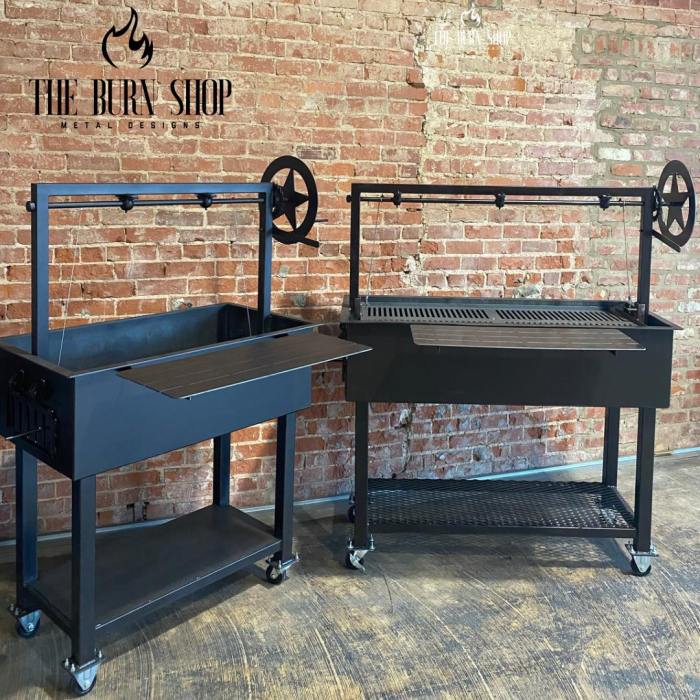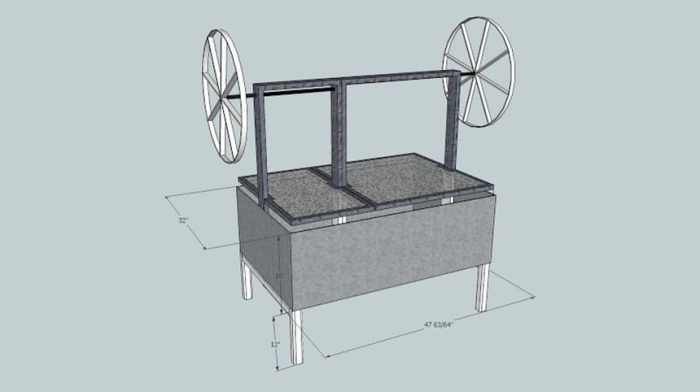DIY Santa Maria Grill: Dive into the world of authentic Santa Maria grilling, where you can create your own custom-built grill to master the art of this unique culinary tradition. This guide will take you through every step of the process, from choosing the right materials and designing your grill to mastering the essential cooking techniques that define this beloved style.
Santa Maria grilling, originating in the heart of California, is known for its distinctive smoky flavor and char, achieved through the use of red oak wood and a specific grilling method. Building your own Santa Maria grill allows you to personalize the experience, ensuring you have the perfect setup to enjoy this traditional grilling style in your own backyard.
Introduction to DIY Santa Maria Grill

Santa Maria-style grilling is a unique and beloved method of cooking that originated in the Santa Maria Valley of California. It’s characterized by its simple yet flavorful approach, using only a few key ingredients and a specialized grill to achieve a distinctive smoky and savory taste.
The Santa Maria grill is a unique type of grill that plays a crucial role in achieving the characteristic flavor of this cooking style. It’s typically constructed from a large, rectangular metal frame with a raised grate, and it’s often fueled by red oak wood. The grill’s design allows for indirect heat distribution, resulting in a more even cooking process and a unique smoky aroma.
History of Santa Maria Grilling, Diy santa maria grill
The Santa Maria Valley has a rich history of cattle ranching, and the local vaqueros (cowboys) developed a method of grilling meat over open fires using the abundant red oak trees in the area. This tradition evolved over time, and by the early 20th century, the Santa Maria barbecue had become a staple of the local community. Today, Santa Maria-style grilling is celebrated annually with the Santa Maria Barbecue Festival, attracting thousands of visitors each year.
Choosing the Right Materials: Diy Santa Maria Grill

The foundation of your Santa Maria grill is its construction, and selecting the right materials will determine its longevity and performance. While traditional Santa Maria grills are known for their simplicity, using readily available materials, there are various options to consider, each with its own advantages and disadvantages.
Types of Wood
The heart of a Santa Maria grill is its firebox, and wood is the fuel that powers the flames. Selecting the right type of wood is crucial for both flavor and durability.
- Redwood: Redwood is a popular choice for Santa Maria grills due to its natural resistance to rot and insects. Its tight grain structure makes it durable and resistant to warping, ensuring a long lifespan for your firebox. Redwood also imparts a subtle, smoky flavor to the food, enhancing the overall grilling experience.
- Oak: Oak is another excellent choice for building a Santa Maria grill. Its sturdy, dense wood burns hot and consistently, making it ideal for achieving the high temperatures required for Santa Maria grilling. Oak also offers a rich, smoky flavor that complements various grilled dishes.
- Douglas Fir: Douglas fir is a readily available and affordable option for building a firebox. While it may not be as resistant to rot as redwood, its durability and affordability make it a practical choice for many grill builders.
Steel
Steel is a versatile and durable material often used for Santa Maria grills. It offers several advantages, including:
- Durability: Steel is incredibly strong and can withstand high temperatures, making it suitable for grilling over an open fire. It’s resistant to warping and cracking, ensuring your grill’s structural integrity.
- Heat Retention: Steel readily absorbs and retains heat, ensuring consistent cooking temperatures. This is particularly beneficial for Santa Maria grilling, which requires high heat for searing and charring food.
- Ease of Cleaning: Steel surfaces are relatively easy to clean, making maintenance a breeze. Simply scrub with a wire brush and soap to remove any food residue.
However, steel also has some disadvantages:
- Rust: Steel is susceptible to rust if not properly protected. You’ll need to apply a rust-resistant coating, such as paint or oil, to prevent corrosion and extend the lifespan of your grill.
- Heat Transfer: Steel conducts heat quickly, making it important to handle hot surfaces with caution. You’ll need to wear gloves or use tools to avoid burns.
- Cost: Steel can be more expensive than other materials, especially for thicker gauge steel that offers greater durability.
Brick and Concrete
Brick and concrete are often used for building the base and walls of a Santa Maria grill. They offer excellent durability and heat retention, but also come with their own set of considerations.
- Durability: Brick and concrete are highly durable materials that can withstand the elements and high temperatures associated with grilling. They offer a stable foundation for your grill and can last for decades with proper maintenance.
- Heat Retention: Brick and concrete absorb and retain heat effectively, ensuring consistent cooking temperatures. This is especially important for Santa Maria grilling, which requires sustained high heat.
- Aesthetic Appeal: Brick and concrete offer a rustic and traditional aesthetic that complements outdoor living spaces. They can be used to create unique and personalized grill designs.
However, brick and concrete also have some drawbacks:
- Weight: Brick and concrete are heavy materials, making it challenging to move or relocate the grill. You’ll need a sturdy foundation to support its weight.
- Construction Time: Building with brick and concrete requires more time and effort compared to using steel or wood. You’ll need to plan and execute the construction carefully.
- Cost: Brick and concrete can be more expensive than other materials, especially if you hire a professional to build your grill.
Sourcing Materials
- Local Lumberyards: Lumberyards are excellent sources for wood, including redwood, oak, and Douglas fir. They often have a wide selection of sizes and grades, allowing you to choose the best materials for your grill.
- Hardware Stores: Hardware stores offer a variety of materials, including steel, brick, and concrete. They also carry essential tools and supplies for building your grill.
- Online Retailers: Online retailers can provide a wider selection of materials and tools, especially if you’re looking for specialty items or unique designs. However, be sure to factor in shipping costs.
- Salvage Yards: Salvage yards can be a great source of affordable materials, including steel and brick. You may find unique pieces that can add character to your grill.
With a DIY Santa Maria grill, you’ll not only enjoy the delicious flavors of this classic style but also gain a deeper appreciation for the history and tradition behind it. From the selection of materials to the final grilling session, every step of the process offers a unique and rewarding experience. So, gather your tools, choose your wood, and embark on this exciting journey to create your own Santa Maria grilling paradise.
Building a DIY Santa Maria grill is a great way to enjoy delicious, smoky flavors. You’ll need to gather materials like steel, wood, and firebricks, and then put it all together. While you’re working on your grill, you might also consider setting up a hydroponics DIY system to grow fresh herbs and vegetables to use in your grilled meals.
Once your grill is complete, you’ll be ready to fire it up and enjoy delicious, smoky flavors!
